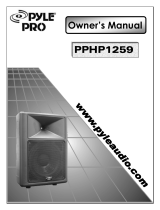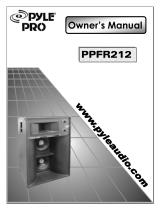Page is loading ...


2
Introduction
Thank you for purchasing this Pyle Pro PADH series speaker. The
loudspeaker is designed to provide you years of high performance in any
application that you require. Please read this manual carefully to fully
maximize the performance of the speaker.
Maintenance and Safety
• Do not expose the speaker to moisture.
• Avoid hot and cold temperature extremes.
• Clean using a damp cloth. Make sure that no moisture contacts the
drivers. You can use a hand vacuum to clean the carpet.
• Do not attempt to service the unit. Refer service to a certified Pyle Pro
technician.
• This loudspeaker is capable of producing extremely high SPL levels.
Use earplugs when necessary.
Features
The PADH series features high-level drivers
and rugged components and is designed for high-
performance applications.
The cabinet features heavy-duty construction
with reinforced corners. It is covered with a black-
carpeted finish that will stand up to years of tour
duty. The integrated handles have been carefully
selected for their ergonomic design and durability.
There are heavy-duty caster wheels for easy
mobility.
The cabinet is loaded with two (2) premium
Kapton voice coil woofers and exhibit excellent
bass response. The compression driver provides
warm midrange reproduction and crystal clear highs
and is complemented by five piezo tweeters.
The integrated passive crossover network is
assembled using quality components and efficiently
directs the frequencies to the proper drivers.

3
Connections
Your PADH series
speaker has an extremely
flexible connection panel.
There are two Speakon jacks
as well as two ¼” jacks. You
can also hookup your speaker
cabinet using the “Quick
Connect” speaker terminals,
which accommodate either
wire leads or a banana plug.
The jacks are wired in
parallel, which allows you to
daisy chain additional
speakers. Thus you can use one amplifier channel to power multiple
speakers.
Make certain that the wires you are using are at least 12 gauge
unshielded speaker cable (the lower the number, the thicker the wire). Do
not use shielded “instrument” cables.
Hooking speakers up in parallel decreases the overall
impedance, placing a greater load on the amplifier. Check your
amplifier’s specifications to ensure that you are not overloading
the channel.
CAUTION: DO NOT USE MORE THAN ONE JACK AS AN
AMPLIFIER INPUT. DOING SO WILL DAMAGE THE SPEAKER!
Amplifier Requirements
Check the product specifications (page 5) to see the power handling
for your model. There are a couple of considerations to keep in mind when
choosing an amplifier to drive your PADH series speaker. While it is true
that an amplifier with a higher power rating can damage the drivers, under-
powering can be even more dangerous. When an amplifier is overdriven and
starts distorting, it generates transient frequencies that are much louder than

4
the program material. These wayward frequencies could damage your
speaker. A proper match is an amplifier which could drive the speaker up to
the cabinet’s RMS rating, without exceeding the amplifier’s own RMS level.
Operation
When powering on your equipment, make sure the volume level on
the amplifier is turned all the way down. This is to avoid the “popping”
noise, which could damage your speaker.
The placement of speakers can be a bit tricky. Besides for the
practical considerations, there are acoustic issues as well. Avoid placing the
speaker in a corner, as this will cause the low frequencies to sound “muddy”.
Similarly, but to a lesser degree, placing the speaker directly against the wall
will exaggerate the low frequencies. You should therefore try to place your
speaker so that it is a few feet away from the wall.
High frequencies are unidirectional while low frequencies are omni
directional. Being that this is a full range enclosure, it is important that the
speaker be placed so that the high frequencies reach the intended listeners
properly. Make certain that no person or object could come to interrupt the
line-of-site between the loudspeaker and the audience.
When using more than one loudspeaker, you have to account for
phase alignment. When the speakers are close together this is not usually an
issue. However, when they are far apart, the sound from one speaker may
reach the ear a fraction of a second before the other. This will cause certain
frequencies to cancel out, resulting in a hollow sound. To avoid this, you
may have to use a delay processor to align the sound from the speakers.

5
Troubleshooting
No Sound:
Check connections
Try a different speaker cable
Check levels on amplifier
Confirm amplifier is getting a signal (check signal LED, or use
headphone output)
Intermittent Output:
Check connections
Try a different speaker cable
Weak Bass:
Check the polarity of the speaker connection. It may be reversed.
Listen with headphones to confirm the amplifier is being sent a good
signal.
Distorted Sound:
Check if the amplifier is overdriven. If it is, you will have to turn the
level down.
Make sure you are not exceeding the RMS rating of your speaker.
Specifications
!
"#$#%
Ω
&
'(#)*
"*%
#)+
,
-
)+.#)+
(
$
")%
/+
/01*0!(
200
#*00
#034
!"*%
5″"*%
67!+
"894%
8Ω
:*#*)+
:#;)+
(:<;+
##;=

6
Parallel Setup
Typical Setup

7
Recommended Accessories
!"
!"
!"
#$%
&'$
( %
)*+
#$%
'$
( %
)*+
Check out these and other accessories at www.pyleaudio.com
/











